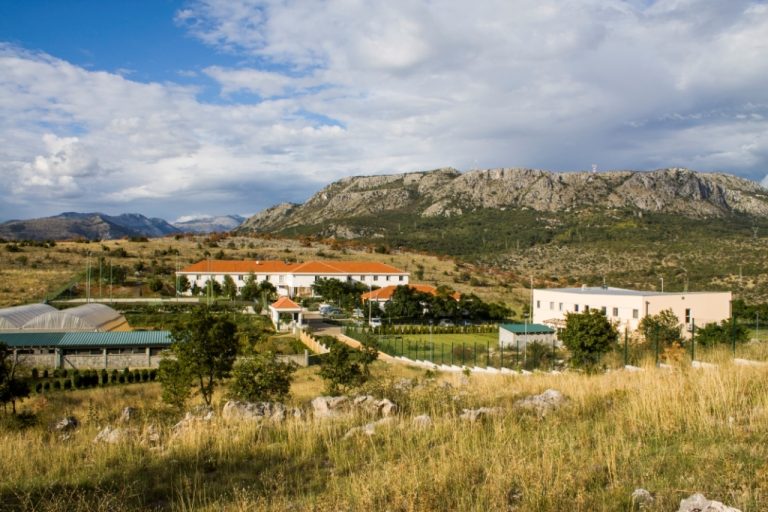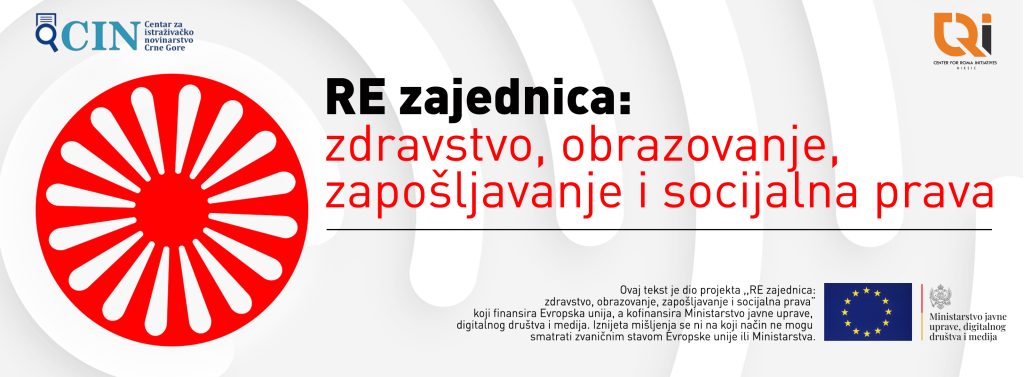DRUGS ARE EASILY AVAILABLE IN THE SETTLEMENT OF VRELA RIBNIČKA: CHILDREN VICTIMS OF DEALERS

Even the youngest in Podgorica's Roma settlements are exposed to illegal substances, which seriously endanger their health, further hinder socialization and escape from poverty
Đurđa RADULOVIĆ
I tried marijuana and cocaine at the age of 13, Lejla, a Roma girl (real name known to the editorial office), tells the Center for Investigative Journalism of Montenegro (CIN-CG). She is still a minor, so the journalist obtained guardian's permission to talk to the girl.
Lejla is smiling, seems relaxed, and very approachable. Her eyes are filled with curiosity. She talks openly about his traumatic childhood, filled with insecurity. Her mother left her, her brothers, and her sister when she was only five. The other children were even younger. After a few years, the father went abroad and started a new family. He left the children with an older relative. Lejla says that she sometimes went to elementary school, but she does not know if she finished it or if she has a degree.
"I wander with my friends a lot," she says, talking about her early teenage years.
"We begged in different cities, I didn't come home for months, we did all kinds of things," she says.
At that time, she hung out with Roma children, but also adult dealers and other criminals, among whom there were also those from other communities. Drugs were easily available.
"There was always marijuana, cocaine, and heroin. I don't know from where", she recalls.
Many members of the Roma community with whom she hung out during her early teenage years were arrested for selling drugs, she explains. Some of the names from that period that she mentions, including the police inspector, were prosecuted for the criminal offense of drug trafficking, and other offenses - such as physical abuse.
Lejla saw a lot as a teenager. She recalls a friend whose body was found in Cijevna. She believes that she overdosed and was pushed into the river.
In some parts of the settlement of Vrela Ribnička, drugs are easy to find, dealers are everywhere, and the prices are several times lower than in the city; several interlocutors who wanted to remain anonymous and were involved in work with the Roma community in that Podgorica settlement, where some of our sources live, told CIN-CG.
Drug addicts also know this neighborhood.
"When I went there to get drugs, children ran after me and asked me: 'What do you need?'" said a former addict who wanted to remain anonymous.
He used to buy heroin there.
"I could find a quarter of a gram for two and a half euros, while in other places, it was at least 10," he says.
"People use various things here, from alcohol to illegal substances," an elderly resident of Vrela Ribnička told CIN-CG.
He also admits taking all kinds of things.
"There is no other way to survive all this," he says and points with his hands to the dusty track made of macadam and gravel.
He no longer consumes anything, but his health is impaired. He claims that children take drugs from their early teenage years, and it is not uncommon to see a small child smoking.
The Police Administration did not respond to CIN-CG's three-times request, despite numerous calls, whether there is a higher rate of drug trafficking in the Roma settlements of Vrela Ribnička and Konik compared to other parts of Podgorica. We did not even get answers to the questions of whether children are involved in the process of selling narcotics and whether it is easier to get drugs in those neighborhoods.
According to the writings of several media, the police representatives were involved in the criminal activities of drug dealing and also operated in the neighborhoods where the most vulnerable live.
The Police Administration did not even answer CIN-CG's question whether their employees were part of a criminal organization that operated in Vrela Ribnička.
The spokesperson of the Police Administration, Marija Žugić, confirmed for CIN-CG that the questions had arrived and were forwarded to those responsible in that institution.
Unemployment, poverty, crime...
"The European School Survey Project on Alcohol and Other Drugs (ESPAD) survey conducted by the Institute for Public Health in 2019 among high school students up to the age of 16 shows that drugs are available in Montenegro regardless of the region or social status the young people come from. This research shows that almost a third of high school students up to the age of 16 believe that they can get marijuana if they want to. A fifth of them believe that they can also get MDMA (ecstasy), and 15 percent cocaine and amphetamine. The settlement of Vrela Ribnička in Podgorica, in the worst-case scenario, deviates from the average, but nothing more than that. All this is very important to emphasize in order not to continue with the stigmatization of Roma and Egyptians, who make up the largest part of the population of this settlement", the Montenegrin Harm Reduction Network LINK told CIN-CG.
The research of the Ombudsman of Montenegro from 2018 also showed that more than 25 percent of students believe that it takes from 30 minutes to, at most, a few hours to get hold of drugs, which is a sign of easy availability.
"Field data shows that drugs are present in the settlement of Vrela Ribnička in Podgorica and that there is a perception of its availability and that it is possible to obtain it more easily than in other parts of the city. However, these are not research data but observations from the field, so it is possible to reach wrong conclusions that would contribute to increasing the already pronounced stigmatization of Roma and Egyptians. Therefore, drugs are not ubiquitous in this neighborhood. We are only talking about an increased risk", the LINK representatives told CIN-CG.
Drug use, as well as the age at which a person starts using drugs, cannot, in any case, be linked to belonging to a particular ethnic group, they emphasize.
"Living conditions can influence someone to start using drugs. In that context, we can only talk about the increased risk of young people from these neighborhoods taking drugs," they said.
An article by the American Psychological Association (APA) states that numerous studies show that children who grow up in socially disadvantaged neighborhoods more easily develop a tendency to addiction. Research that included 11,000 children from 21 cities in the United States showed that those from poor communities have a higher chance of developing addiction habits.
Even if a child grows up in a financially and socially stable family, his psychological development will be significantly slowed down if he grows up in a neighborhood with a large number of unemployed people, poverty, crime, and the like. Such a child will have a greater chance of becoming an addict due to the influence of the settlement, the APA article explains.
Drug rehabilitation unaffordable for the poorest
When talking about the prevention of the use of psychoactive substances (PSs), this community is neglected, which shouldn't be the case, Marija Mijović from NGO Juventas tells CIN-CG.
"This community, partly due to the way of life and the high degree of stigma and discrimination that they inevitably face, do not always have access to the information they need, as well as preventive services that could potentially prevent the first use of PSs. This community is not in an enviable position when it comes to addiction rehabilitation options either, especially considering their often unregulated legal status that makes it difficult for them to access a health system that offers free addiction treatment. They can't pay for treatment options available in Montenegro," Mijović says.
"Rehabilitation options such as treatment in Podgorica's Kakaricka Gora, an institution for accommodation, rehabilitation, and resocialization of users of psychoactive substances, are not available to all members of this community, so we appeal to provide free treatment whenever possible," Mijović explains.
The NGO Juventas actively provides services to the Roma and Egyptians community through Drop-in centers and by holding activities aimed at psychosocial support and empowerment of members of this community, Marija Mijović added.
The Public Institution "Kakaricka gora" tells CIN-CG that the price of participation has been reduced from 330 to 230 euros and that the entire program is free for the citizens of Danilovgrad and Tivat because those municipalities have taken over the participation costs.
"In the hope that other municipalities will do the same according to their capabilities, we use every public opportunity to appeal for support and changes. We emphasize that the full price of the treatment at the institution is a total of 1,000 euros per month, but that the difference from the 230 euros co-payment up to the full amount is borne by the City of Podgorica, regardless of whether the clients are from Podgorica", Dijana Milošević, director of Kakaricka gora tells CIN-CG."
The Red Cross of Montenegro explains that for years, they have been helping Roma and Egyptians in various ways and that workshops were held to prevent addiction. The workshops were attended mainly by women.
There is no treatment for addiction in children
"Our country does not have an institution that deals with minors suffering from addiction. The issue is also the lack of child psychiatrists to whom these children could be referred for treatment. There is no continuous education and work on preventing first use in children", Marija Mijović says.
The NGO Juventas deals with young people, but minors who use PSs. They can only be supported with the presence of their parents or guardians, she explains.
Regarding prevention, continuous and effective programs funded by the state are essential, Mijović claims.
CIN-CG approached the Ministry of Health regarding the problem of the lack of an institution that deals with addictive diseases in children, but there was no response.
"The abuse of psychoactive substances when it comes to children from the Roma and Egyptian community, due to additional poverty, can affect young people as well so that after becoming addicted, they use the cheapest drugs that quickly destroy the body," Jovana Knežević from the Center for Roma Initiatives told CIN-CG.
The issue of the use of illegal substances further complicates social inclusion, which is already imbued with numerous challenges, Knežević explains.
Lejla spent about a year in a state institution that houses children without appropriate care. There, she stopped using opioid substances for good, but it was very challenging.
"I went wild. I was furious to be locked up there. They kept giving me pills in the evening to calm me down."
She says she hates that period of her life.
"Older boys sexually harassed me. I didn't feel safe…".
Today, she lives with her cousin, who is her guardian, and her younger brothers. Her cousin often reminds her that when she becomes an adult, she will have to become financially independent, Lejla says.
"I don't know how to find a job. I can read and write, but that is not enough", she says.
She regrets that her younger sister lives as she did until a few years ago.
"She now lives in that world... She's begging, wandering. She doesn't know where she lives. She hasn't been home for months. I hope she doesn't take drugs", says our young interlocutor, and her pleasant face becomes worried and sad.
Residents of the Ljubović Center mainly test positive for drugs
In about 80 percent of cases, the minors who come are positive on the psychoactive substances (PSs) test, Nina Delević, director of the Ljubović Center, an institution for juveniles with behavioral problems, tells CIN-CG.
She explains that this is also the case with children who come from other institutions, such as the Department for Juveniles at the prison in Spuž.
The prison in Spuž did not answer the question of CIN-CG whether they were aware that their minor wards come into contact with illegal substances and why this happens.


